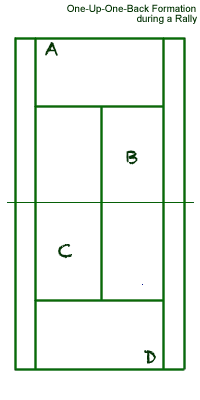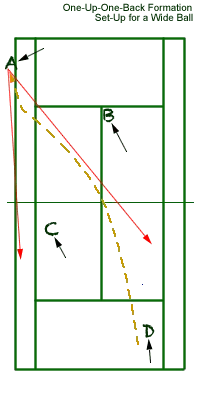One of the frequent situations I see in doubles is the confusion about how the players should position when a ball is sent wide into the court forcing the closest player (A in the graphics) out of bounds (beyond the doubles line).

In graphic 1 (above), we have the standard One-Up-One-Back formation, before the wide ball has been executed.
In the second graphic (below), we’ll assume that player D has just hit a wide-angled cross-court toward player A’s alley.
Player A moves wide to retrieve the ball. What happens next is what generates confusion for most of the players.
I have heard all these theories about the “rope”, stating that player B should move closer to player A’s alley to keep the distance between the two players like there is an invisible rope pulling them together. Or, player B should cover the middle; and so on…
But what about players C and D? How should their position be on the court to defend/ attack once they hit a wide shot toward their opponents?
In graphic (2) below, I would like to explain and demonstrate the proper movement and court coverage of all the players involved in playing a wide ball:

As you see in the graphic above, player A moves outside the alley to retrieve the wide ball sent in her direction.
What her partner does is the key part of their defense:
Player B should (when she sees her partner moving wide) back up toward the service line and closer to the center line (see graphic 2). By doing this, she will be not only covering the opening created by pulling player A wide but also opening the court for a cross-court shot option for her partner (A) and also by positioning further back she allows herself more time to react to an eventual attack from the opposing net player.
Player D (who sent the wide ball) will move inside the baseline in order to cover an eventual sharp cross-court shot coming from player A but not too far inside the baseline so that she can cover the possible lob over her partner (C).
Player C should first move wide to cover the possible down-the-alley shot and second, she must come more forward toward the net to cut the eventual cross-court return from player A.
So as you see in the second figure (above), the teams, in order to play a wide ball, in no way should they move together (like they have a string attached to them), like so many of the tennis books suggest.
In fact, they should split a little in order to cover the angles. Angles create angles therefore teams should cover them once they create them.
I would not suggest that teams worry too much about the middle of the court considering that an angled shot since it is returned at an angle will travel mostly toward the alleys.